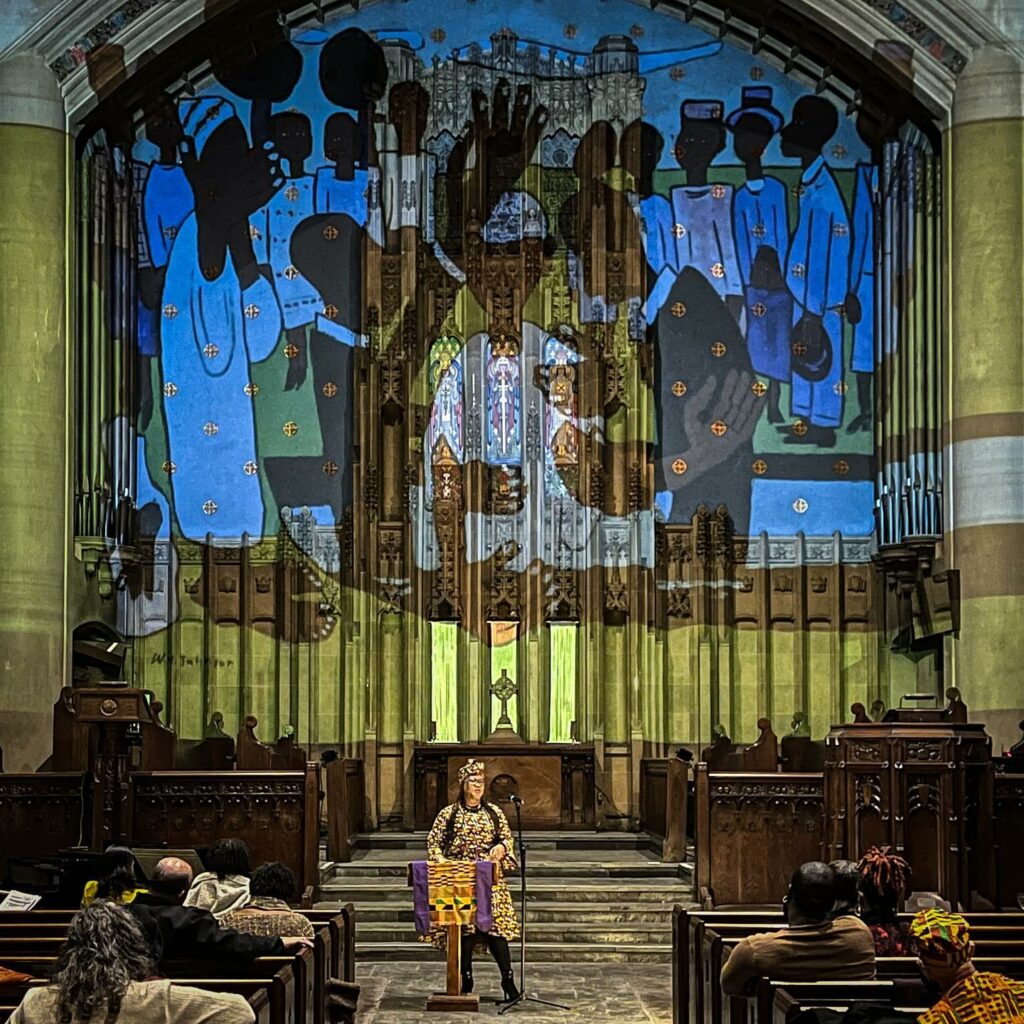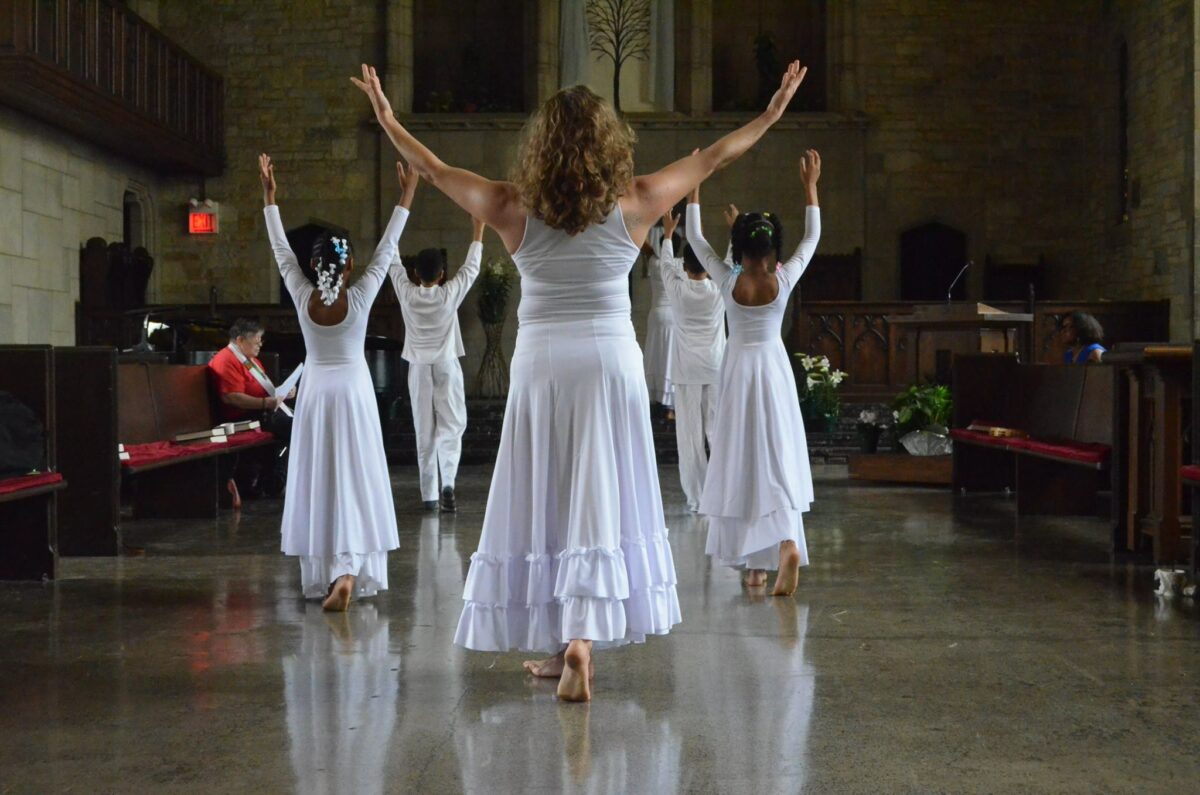Creatives such as Quenna Barrett, a theater director and educator living on the South Side, know far too well about the disparity artists face when carving out their niche on the South Side. Her work with teens requires reliable rehearsal spaces. Barrett, who is currently a Policy Research and Analysis Fellow with Arts Alliance Illinois, notes that “artistic space is not always readily available to artists” on the South Side. So, when Barrett first learned about the pilot program South Side Artists in Sacred Spaces, she was intrigued.
South Side Artists in Sacred Spaces is a program born out of a collaboration between Partners in Sacred Places, Arts Alliance Illinois, and Bustling Spaces LLC. The goal of the program is to help local artists, such as Barrett, and art organizations find an affordable rental space on the South Side by matching them with places of worship that have free space and an interest in earning additional income.
“This program really does help meet the gap, in particular, for artists living and working on the South Side where there are less than a handful of spaces that we would be able to access,” Barrett said.
While similar Artists in Sacred Spaces programs exist in other large markets, like Philadelphia and New York, South Side Artists in Sacred Spaces is the first of its kind in Chicago. The program was developed thanks to feedback that Arts Alliance Illinois received directly from South Side artists.
Bustling Spaces Founder and Executive Director Henry Wishcamper said that Arts Alliance held a series of listening sessions with artists. “It just seemed like a perfect solution to…a problem that we were so clearly… hearing articulated by artists across the South Side.”
To be considered for the program, candidates were required to submit an application before the September 6, 2023 deadline. Those selected for the program are required to complete a five-week training session beginning on October 19, 2023, and ending January 11, 2024. The training will cover a variety of topics such as: mission and vision alignment, envisioning the sacred space, legal ins and outs, and areas of discernment.
According to program organizers, no artistic specialty is off limits and the art itself does not have to be sacred. Artists can have a business address anywhere in the city; however the focus of their work must be within a neighborhood south of I-55 and within Chicago city limits.
“I think on the artist’s side,” Wishcamper said, “the only criteria we’re really using to judge is, one, do you want to be working in a sacred space? And two, do you want to be working with and creating art for existing South Side communities?”

Requirements for houses of worship are similar to those required of the artists. They must be located on the South Side, interested in activating their underutilized space, and fall within the category of a ‘sacred space’ which the program designates as a church, synagogue, mosque, or other neighborhood places of worship.
“The sacred spaces that we are hoping will participate are on the South Side…and should be congregations that are open, willing, and excited to share their spaces,” said Associate Director of Community Engagement for Partners for Sacred Places, Sarah Jones.
Reverend David J. Black of The First Presbyterian Church of Chicago, located at 6400 S. Kimbark Avenue, is one congregation leader who is willing and excited to share space with a partner artist.
“We see artists as being very essential to our own faith and our [own] religion,” Black said. “We really view artists as prophets who are seeing the world around us in unique terms that aren’t defined by history or sociology.”
In addition to space-sharing, once artists and congregations successfully complete the training program, they will be eligible to receive grant money. Artists are eligible to apply for rental assistance and congregations for capital grants.
South Side Artists in Sacred Spaces will distribute a total of $135,000 in capital grants to congregations to improve their building’s accessibility and attractiveness to arts organizations.
For Reverend Black, capital grant money for his historic church, which was organized in June of 1833, could be used to make improvements in essential areas within the church.
“Having a dignifying space dignifies the people there and is so important for the flourishing of culture. We don’t just want artists to come into space that’s half maintained,” Black said. “The other thing is providing ADA-standard accessibility in the building, which is a really difficult project for a lot of Chicago churches that are older and were built when there were no standards.”
Funding projects will be a collaborative effort between the congregation and an artist partner. As a requirement, congregations must match the grant amount given by the Arts Alliance for their project with other funds. An estimated seven to ten grants are expected to be distributed.
South Side Artists in Sacred Spaces will also distribute a total of $20,000 to artists towards rental assistance to help them build their presence and/or programming in the sacred space. Rental assistance will only be granted to those who utilize space within their designated house of worship and funds will be distributed directly to the house of worship on behalf of each artist.
The program is supported by a Chicago Arts Recovery Program grant from the City of Chicago Department of Cultural Affairs and Special Events. The project is supported by federal assistance listing number 21.0237 awarded to Arts Alliance Illinois by the U.S. Treasury through the American Rescue Plan Coronavirus State and Local Fiscal Recovery Funds in the amount of $235,000, representing 100% of total funding.
“I think this is sort of helping artists to think outside of the box,” said Barrett. “That you could absolutely partner in a huge way where it could be mutually beneficial to both the sacred spaces as well as the artistic practice.”If you would like to know more about the South Side Artists in Sacred Spaces program, visit: https://sacredplaces.org, or you can contact Sarah Jones via email at sjones@sacredplaces.org.
Dierdre Robinson is a writer and accounting manager in Chicago. She has a BA in Journalism from Michigan State University. She last wrote about Kia S. Smith and Memoirs of Jazz in the Alley for the Weekly.

